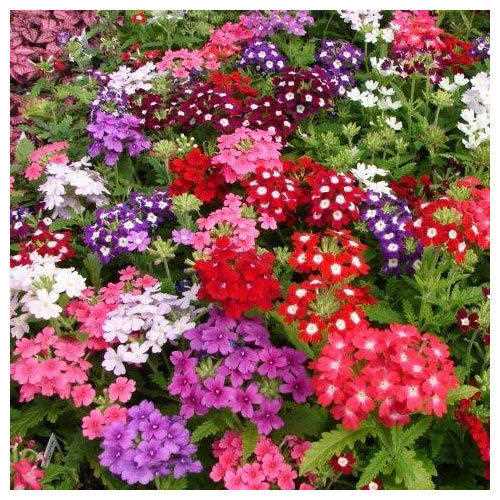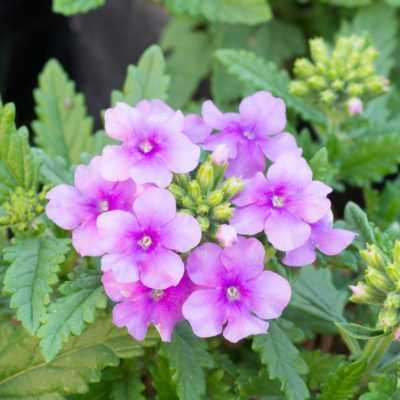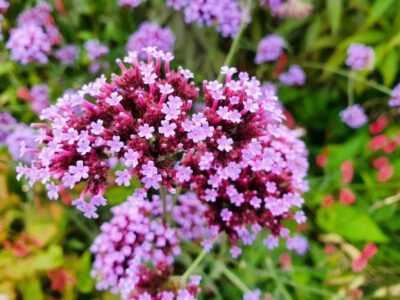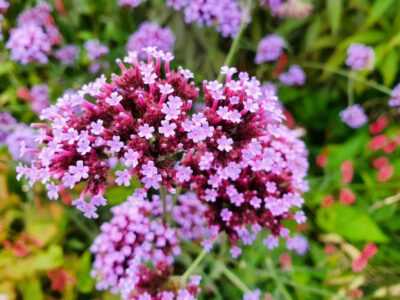- Choosing the right Varieties
- Here are some popular varieties of Verbena to consider:
- Selecting the ideal Growing Location
- Sunlight Requirements
- Soil Conditions
- Air Circulation
- Protection from Frost
- Consider Container Growing
- Summary
- Preparing the Soil for Verbena
- 1. Choose the Right Location
- 2. Clear the Area
- 3. Loosen the Soil
- 4. Improve Drainage
- 5. Test the pH
- 6. Fertilize
- 7. Water the Soil
- Planting Verbena Seeds or Seedlings
- Planting Verbena Seeds:
- Planting Verbena Seedlings:
- Providing the Optimal Watering and Fertilization
- Watering
- Fertilization
- Protecting Verbena from Pests and Diseases
- Pests
- Diseases
- Pruning and Trimming Verbena for Proper Growth
- 1. Timing
- 2. Tools
- 3. Deadheading
- 4. Removing Old Growth
- 5. Cutting Back
- 6. Maintenance Pruning
- Troubleshooting Verbena Flowering Issues
- Lack of Flowering
- Few Blooms
- Pest and Disease Issues
- Questions and Answers:
- What is verbena?
- How do I grow verbena from seeds?
- What are the different types of verbena?
- How often should I water verbena plants?
- Can verbena be grown in containers?
- When does verbena start to flower?
- What are some common problems and pests that affect verbena plants?
- Videos: Growing Beautiful Verbena Flowers — and a Tour of Blooms

Verbena, also known as vervain, is a beautiful flowering plant that can add vibrant color to any garden or landscape. With its delicate clusters of flowers in various shades of purple, pink, and white, verbena is a popular choice among gardeners for its ornamental value. But growing verbena is not just about the stunning blooms – it is also a relatively easy plant to cultivate from seed to full flowering.
If you are considering growing verbena in your garden, this complete guide will provide you with all the information you need to successfully grow and care for this exquisite plant. From sowing the seeds to encouraging healthy growth and blooming, we will cover every step of the process.
Verbena belongs to the Verbenaceae family and is native to both the Americas and Europe. It is an annual or perennial herbaceous plant, depending on the species, and can grow up to 3 feet tall. The plant has slender, wiry stems with small serrated leaves. Its flowers are typically small and tubular, arranged in clusters atop the stems. Verbena is known for attracting butterflies, bees, and other pollinators, making it a great addition to any pollinator-friendly garden.
When it comes to growing verbena from seed, it’s important to choose the right varieties and provide optimal growing conditions. Whether you opt for the common garden verbena (Verbena x hybrida) or the native American verbena (Verbena hastata), you will have a wide range of choices in terms of flower color, size, and growth habit. With proper care and attention, your verbena plants will reward you with abundant blooms throughout the growing season.
Choosing the right Varieties
When it comes to choosing the right varieties of Verbena for your garden, there are several factors to consider. First, think about the climate in your area. Verbena is a perennial plant that is native to warm, tropical climates. However, there are also varieties that can tolerate cooler temperatures.
Next, consider the purpose of your Verbena. Are you looking for a ground cover that will spread and fill in bare areas of your garden? Or are you looking for a variety that will produce beautiful flowers for cutting and arranging? Different varieties of Verbena have different growth habits and flower characteristics, so it’s important to choose one that suits your needs.
Here are some popular varieties of Verbena to consider:
- Tapien Verbena: This variety is known for its trailing habit, making it perfect for hanging baskets or as a ground cover.
- Homestead Purple Verbena: As its name suggests, this variety produces beautiful purple flowers and is a great choice for adding color to your garden.
- Imagination Verbena: If you’re looking for a Verbena with unique flower colors, consider this variety, which produces blooms in shades of pink, coral, and apricot.
- Lollipop Verbena: This compact variety is perfect for smaller gardens or containers. It produces clusters of pink, purple, or white flowers.
Once you have chosen the right varieties, it’s time to start growing your Verbena. Check out our guide on how to sow Verbena seeds and care for your plants to ensure a successful growing season.
Selecting the ideal Growing Location
Sunlight Requirements
Verbena plants thrive in full sunlight, so it is important to choose a location that receives at least 6-8 hours of direct sunlight each day. Placing your verbena in a spot with insufficient sunlight can result in weak, leggy plants that produce fewer flowers.
Soil Conditions
Well-draining soil is essential for the successful growth of verbena plants. The soil should have a pH level between 6.0 and 7.5, which is slightly acidic to neutral. Avoid heavy clay soils that retain too much moisture, as this can lead to root rot. Sandy or loamy soils are preferable as they provide good drainage.
Air Circulation
Good air circulation is crucial to prevent diseases and promote healthy growth. Avoid planting verbena in areas with dense foliage or where there is limited airflow. Providing enough space between plants will help prevent the spread of diseases and allow the leaves to dry quickly after rainfall or irrigation.
Protection from Frost
If you live in an area with frost, it is important to select a location that offers some protection. Verbena plants are not frost-tolerant, so planting them in a sheltered spot, such as near a wall or under the eaves of a building, can help protect them from frost damage. Alternatively, you can cover the plants with a frost blanket during cold spells.
Consider Container Growing
If you have limited space or poor soil conditions, verbena can also be grown in containers. Choose a spacious container with drainage holes and fill it with a well-draining potting mix. Place the container in a location that receives ample sunlight and ensure it is protected from strong winds.
Summary
- Select a location with full sunlight for at least 6-8 hours per day.
- Choose well-draining soil with a pH level between 6.0 and 7.5.
- Avoid areas with poor air circulation.
- Provide protection from frost if necessary.
- Consider growing in containers if space or soil conditions are an issue.
Preparing the Soil for Verbena
Before you start planting verbena, it is important to prepare the soil properly. Good soil preparation will help ensure healthy growth and abundant flowering of this beautiful plant.
1. Choose the Right Location
Verbena thrives in well-draining soil and full sun. Choose a location in your garden that receives at least 6-8 hours of direct sunlight per day. Avoid areas with heavy clay soil or poor drainage, as this can cause root rot and other problems.
2. Clear the Area
Before you begin preparing the soil, clear the area of any weeds or grass. Remove any debris or large stones that may hinder the growth of the plants.
3. Loosen the Soil
Using a garden fork or a tiller, loosen the soil to a depth of about 12-18 inches. This will help improve drainage and encourage better root development.
4. Improve Drainage
If your soil tends to be heavy or clay-like, you can improve drainage by adding organic matter such as compost or well-rotted manure. Spread a 2-3 inch layer of organic matter over the soil and mix it in thoroughly.
5. Test the pH
Verbena prefers slightly acidic to neutral soil, with a pH range of 6.0-7.5. You can test the pH of your soil using a soil testing kit easily available at gardening centers. If the pH is too acidic or alkaline, you can adjust it by adding lime to raise the pH or sulfur to lower it.
6. Fertilize
Verbena is a nutrient-hungry plant, so it is important to fertilize the soil before planting. Use a balanced, slow-release fertilizer according to the manufacturer’s instructions. Spread it evenly over the soil and gently work it into the top few inches.
7. Water the Soil
Prior to planting verbena, thoroughly water the soil to ensure it is evenly moist. This will help settle the soil and provide a good environment for the roots to establish.
By following these soil preparation steps, you will create an optimal growing environment for your verbena plants, setting them up for success as they grow and bloom beautifully.
Planting Verbena Seeds or Seedlings
Verbena can be grown from either seeds or seedlings bought from a nursery. Here are the steps to successfully plant verbena seeds or seedlings:
Planting Verbena Seeds:
- Select a well-draining planting location that receives full sun.
- Prepare the soil by removing any weeds and loosening it with a garden fork or tiller.
- Spread a thin layer of compost or aged manure over the soil and mix it in.
- Sow the verbena seeds directly into the soil, following the packet instructions for spacing and depth.
- Water the seeds gently but thoroughly after planting.
- Keep the soil consistently moist until the seeds germinate, which usually takes 1-2 weeks.
- Thin the seedlings once they have grown a few inches tall, leaving only the strongest ones spaced according to the packet instructions.
- Continue to water the seedlings regularly, keeping the soil moist but not waterlogged.
Planting Verbena Seedlings:
- Select a well-draining planting location that receives full sun.
- Prepare the soil by removing any weeds and loosening it with a garden fork or tiller.
- Dig a hole in the soil that is slightly larger than the container of the verbena seedling.
- Remove the seedling from its container, being careful not to damage the roots.
- Place the seedling in the hole and backfill with soil, gently firming it around the roots.
- Water the seedling thoroughly after planting.
- Continue to water the seedling regularly, keeping the soil moist but not waterlogged.
Whether you choose to start verbena from seeds or seedlings, providing them with proper care and maintenance will ensure healthy plants and abundant flowers.
Providing the Optimal Watering and Fertilization
Proper watering and fertilization are essential for the healthy growth and blooming of verbena plants. Here are some tips to ensure you provide the optimal care:
Watering
- Verbena plants require regular watering, especially during hot and dry periods.
- Water the plants deeply, ensuring the moisture reaches the root system.
- When watering, avoid wetting the foliage to prevent the risk of fungal diseases.
- Check the soil moisture regularly, and water when the top inch of the soil feels dry.
- Use a watering can or drip irrigation system to provide a slow and steady supply of water.
- Water in the morning or early evening to minimize evaporation and allow the leaves to dry before nightfall.
- Be cautious not to overwater, as verbena plants are susceptible to root rot.
Fertilization
- Feed verbena plants with a balanced, water-soluble fertilizer every two weeks during the growing season.
- Choose a fertilizer with an NPK ratio of 10-10-10 or something similar.
- Dilute the fertilizer according to the instructions on the packaging to prevent burning the plants’ roots.
- Apply the fertilizer around the base of the plants, avoiding direct contact with the leaves or stems.
- Water the plants immediately after fertilizing to aid in the nutrients’ absorption.
- During the winter months, reduce fertilization to once every 4-6 weeks or stop altogether.
By providing the correct watering and fertilization, you can ensure that your verbena plants thrive and produce beautiful, vibrant flowers.
Protecting Verbena from Pests and Diseases
Verbena plants are generally hardy and resistant to many pests and diseases. However, it is still important to protect them from potential threats to ensure their health and longevity. Here are some common pests and diseases that can affect verbena plants and how to prevent or treat them:
Pests
1. Aphids: These tiny insects feed on the sap of the plant, causing deformed leaves and stunted growth. To prevent aphids, regularly check the plants for signs of infestation and use insecticidal soap or neem oil to control them.
2. Spider mites: These tiny arachnids can cause yellowing leaves and a web-like substance on the plant. To prevent spider mites, maintain a humid environment around the plant and regularly spray the foliage with water.
3. Whiteflies: These small insects can cause yellowing leaves and stunted growth. To prevent whiteflies, introduce natural predators like ladybugs or use insecticidal soap.
Diseases
1. Powdery mildew: This fungal disease appears as a white, powdery substance on the leaves. To prevent powdery mildew, ensure good air circulation around the plants and avoid overhead watering. If the disease appears, treat it with fungicidal spray.
2. Root rot: Overwatering and poorly-drained soil can lead to root rot, causing yellowing leaves and wilting. To prevent root rot, ensure proper drainage and avoid overwatering. If root rot occurs, remove affected plants and disinfect the soil before replanting.
3. Leaf spot: This fungal disease causes black or brown spots on the leaves. To prevent leaf spot, water the plant at the base and avoid wetting the foliage. If leaf spot occurs, remove and destroy affected leaves and treat with a fungicidal spray.
It is important to monitor verbena plants regularly for any signs of pests or diseases. Early detection and proper treatment will help keep the plants healthy and vibrant throughout the growing season.
Pruning and Trimming Verbena for Proper Growth


Pruning and trimming verbena is an important part of maintaining its health and promoting proper growth. By removing old or damaged growth, you can encourage the plant to produce more flowers and new growth. Here are some tips for pruning and trimming verbena:
1. Timing
The best time to prune verbena is in early spring or late winter, before new growth begins. This allows the plant to recover and start producing new growth as soon as the weather warms up. Avoid pruning verbena during the hot summer months, as it can cause stress to the plant.
2. Tools
Before you start pruning verbena, make sure you have the right tools. Good quality pruning shears or scissors are essential for making clean cuts and preventing damage to the plant. Disinfecting your tools before and after pruning can prevent the spread of disease.
3. Deadheading
Deadheading is the process of removing spent flowers from the plant. This not only makes the verbena look more attractive, but it also encourages the plant to produce more blooms. Deadheading can be done throughout the growing season whenever you notice faded flowers.
4. Removing Old Growth


When pruning verbena, remove any old or dead stems from the base of the plant. This helps improve air circulation and reduces the risk of disease. You can also trim back overgrown or leggy branches to promote a compact and bushy growth habit.
5. Cutting Back
In late summer or early fall, you can perform a more severe pruning called cutting back. This involves trimming the entire plant back to a few inches above the ground. Cutting back helps rejuvenate the verbena and promote a more vigorous growth in the following year.
6. Maintenance Pruning
To maintain a neat and tidy appearance, you can perform occasional maintenance pruning on verbena. This involves trimming back any long or straggly branches to keep the plant compact and well-shaped. Regular maintenance pruning can help prevent the verbena from becoming unruly or overgrown.
Remember to always water the verbena after pruning to help it recover from the stress of cutting. With proper pruning and trimming, your verbena will thrive and reward you with abundant blooms throughout the growing season.
Troubleshooting Verbena Flowering Issues
Lack of Flowering


If your verbena plants are not producing flowers, there could be a few potential causes:
- Insufficient sunlight: Verbena plants require full sun exposure to bloom. Make sure your plants are receiving at least 6-8 hours of direct sunlight per day.
- Over-fertilization: Excessive use of nitrogen-rich fertilizers can promote leafy growth at the expense of flowers. Use a balanced fertilizer with a lower nitrogen content to encourage flowering.
- Improper pruning: Verbena plants may need occasional pruning to promote flowering. Trim back any dead or leggy growth to encourage new blooms.
- Mature plants: Sometimes, verbena plants may take a year or two to establish themselves before they start flowering. Be patient and give them time to mature.
Few Blooms
If your verbena plants are producing only a few blooms, consider the following factors:
- Overcrowding: If your verbena plants are planted too close together, they may compete for resources and result in fewer blooms. Space them out to allow proper airflow and sunlight penetration.
- Poor soil quality: Verbena plants prefer well-draining, fertile soil. If your soil is heavy and compacted, it may inhibit flower production. Amend the soil with organic matter to improve its quality.
- Inconsistent watering: Inadequate or inconsistent watering can lead to stress and reduce flower production. Keep the soil consistently moist, but not waterlogged, to encourage blooming.
Pest and Disease Issues
Common pests and diseases that can affect verbena plants include:
| Pest | Symptoms | Treatment |
|---|---|---|
| Aphids | Curling leaves, sticky residue | Use insecticidal soap or neem oil |
| Whiteflies | Tiny white insects, yellowing leaves | Use insecticidal soap or neem oil |
| Powdery mildew | White powdery coating on leaves | Apply fungicide specifically labeled for powdery mildew |
| Root rot | Yellowing leaves, wilting | Improve soil drainage, avoid overwatering |
If you notice any signs of pests or diseases on your verbena plants, take appropriate action promptly to prevent further damage.
Questions and Answers:
What is verbena?
Verbena is a flowering plant that belongs to the Verbenaceae family. It is known for its vibrant and colorful flowers and is often used as a decorative plant in gardens.
How do I grow verbena from seeds?
To grow verbena from seeds, start by filling a seed tray with a well-draining potting mix. Moisten the soil before sowing the seeds on the surface. Lightly cover the seeds with a thin layer of soil and place the tray in a warm and sunny location. Keep the soil moist and the seeds should germinate within two weeks.
What are the different types of verbena?
There are several different types of verbena, including Verbena bonariensis, Verbena rigida, Verbena canadensis, and Verbena hybrida. Each type has its own unique characteristics and growth habits.
How often should I water verbena plants?
Verbena plants should be watered regularly, especially during hot and dry weather. It is important to keep the soil evenly moist, but not waterlogged. Watering once or twice a week, depending on the weather conditions, should be sufficient.
Can verbena be grown in containers?
Yes, verbena can be grown in containers. It is important to choose a container with good drainage and use a well-draining potting mix. The containers should also be large enough to accommodate the root system of the plant. Regular watering and fertilizing will be necessary for verbena grown in containers.
When does verbena start to flower?
Verbena plants typically start to flower in mid to late spring or early summer, depending on the specific variety and growing conditions. Once they start flowering, verbena plants will continue to produce flowers throughout the summer and into the fall.
What are some common problems and pests that affect verbena plants?
Some common problems and pests that affect verbena plants include powdery mildew, aphids, and spider mites. Powdery mildew can be prevented by spacing the plants properly to encourage good air circulation and avoiding overhead watering. Aphids and spider mites can be controlled by using insecticidal soap or neem oil.







